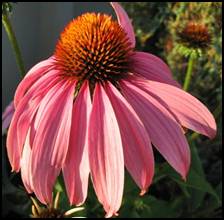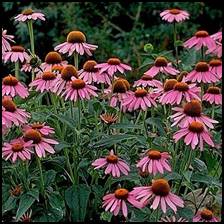
Echinacea
SCIENTIFIC NAME:(Echinacea pallida)
Echinacea is a genus of herbaceous flowering plants in the daisy family, Asteraceae. The nine species it contains are commonly called purple coneflowers. A drought-tolerant perennial, Echinacea grows up to 140 cm in height. They have erect stems that in most species are un-branched. Both the basal and cauline leaves are arranged alternately. The leaves are normally hairy with a rough texture.
Like all Asteraceae, the flowering structure is a composite inflorescence, with purple (rarely yellow or white) florets arranged in a prominent, somewhat cone-shaped head – "cone-shaped" because the petals of the outer ray florets tend to point downward (are reflexed) once the flower head opens, thus forming a cone. Plants are generally long lived, with distinctive flowers. The common name "cone flower" comes from the characteristic center “cone” at the center of the flower.
Common Names:
Purple Coneflower, Coneflower, American Coneflower, Comb Flower, Hedgehog, Indian Head, Scurvy Root

Uses:
The components of Echinacea that give it its immune-enhancing effects are polysaccharides, alkylamides and cichoric acid. These elements not only enhance the activity of the immune system, but are said to relieve pain, reduce inflammation, and have hormonal, antiviral, and antioxidant effects. For this reason, professional herbalists may recommend Echinacea to treat urinary tract infections, vaginal yeast (candida) infections, ear infections (also known as otitis media), athlete's foot, sinusitis, hay fever (also called allergic rhinitis), as well as slow-healing wounds. One study even suggests that Echinacea extract exerted an antiviral action on the development of recurrent cold sores triggered by the herpes simplex virus (HSVI) when supplied prior to infection.Whether or not Echinacea helps prevent or treat the common cold remains under debate. Some say that the herb can make you feel better faster. Others suggest that Echinacea has no impact on a cold at all. Some people say taking Echinacea as soon as they feel sick reduces the severity of their cold and that they have fewer symptoms than when they don’t use it. There is also evidence to suggest that Echinacea can be useful as a preventative against catching a cold.
When choosing Echinacea products, be sure they are made from the root of the plant, as that is where all three components have the highest concentration.
Applications:
Tea:
A minimum of three cups per day.
Capsule:
Follow label instructions.
Powder:
900 mg. twice times a day.
Extracts:
3 to 4 ml. three times a day.
Warnings:
It should not be used for more than 10 days. The use in children below 1 year of age is contraindicated, because of theoretically possible undesirable effect on immature immune system. The use in children between 1 and 12 years of age is not recommended, because efficacy has not been sufficiently documented although specific risks are not documented. In the absence of sufficient data, the use in pregnancy and lactation is not recommended.
With any herb, there is the risk of an allergic reaction. Small children and pregnant women should use additional caution when considering the use of herbal remedies.





